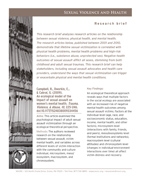- January 08, 2013
- Ali Mailen Perrotto
This tool focuses on how all CommunitiesCover adults in a community can support child sexual abuse prevention efforts and promote healthier environments for children. In Spanish. Publish Date January 2013
- January 08, 2013
- Ali Mailen Perrotto
Esta herramienta brinda SpanOverview una visión general del desarrollo sexual saludable de niñas y niños. Sugiere conductas y habilidades apropiadas a la edad, además de proporcionar información que apoya el desarrollo sano. En inglés. Publish Date January 2013
- January 04, 2013
- Ali Mailen Perrotto
Sexual violence is a complex topic, and journalists reporting on it should be aware that the process can be different from reporting on other crime-related stories. Some survivors may want to talk with the media, while others may not. Remember this is a social justice issue, so there are plenty of story angles and not all include interviewing survivors. Regardless of the angle, infusing stories with data and background information puts this issue into context. Here are some tips for reporters to consider when talking with survivors of sexual violence. Publish Date 2013, 2015
- December 19, 2012
- Ali Mailen Perrotto
This is the final report from the NSVRC’s three-year National Prevention Strengths and Needs Assessment Project, and provides a summary of the work completed during the third year of the assessment as well as a synthesis of major themes across the three-year project. The major activities of the Year 3 assessment were the completion of a national survey comparison of findings to the Year 1 survey. You can find the 2 previous reports here: NSVRC Prevention Assessment: Year 1 Report National Strengths and Needs Assessment (NSVRC, 2010) NSVRC Prevention Assessment: Year 2 Report
- October 26, 2012
- Ali Mailen Perrotto
Negative health outcomes of sexual assault afflict all sexes, stemming from both childhood and adult sexual traumas. This research brief can help stakeholders, including sexual assault advocates and health care providers, understand the ways that sexual victimization can trigger or exacerbate physical and mental health conditions. Publish Date October 2012
- October 01, 2012
- Ali Mailen Perrotto
This information packet describes practices used in cases of human trafficking, how they relate to sexual violence, and how to assist and advocate for victims of human trafficking. There are 6 resources in this information packet. The packet includes: an Annotated Bibliography, a Technical Assistance Bulletin, an Overview, a Guide for Advocates, a Research Brief, and a Resource List. Publish Date October 2012
- October 01, 2012
- Ali Mailen Perrotto
The purpose of this research brief is to review research on the relationship between sexual violence and trafficking (especially, but not limited to, sex trafficking) and shed light on gaps in existing research. The documents reviewed in this brief discuss trafficking, the frequency of sexual violence against trafficking victims, health concerns of victims, and strategies for outreach to victims. This research brief is part of the Assisting Trafficking Victims Information Packet. View the full packet or other publications included in this packet. Publish Date October 2012
- October 01, 2012
- Ali Mailen Perrotto
This technical assistance guide provides information about the prevalence of sexual violence throughout various forms of human trafficking. The content of this guide is intended to support community-based advocates working in their outreach and service provision to trafficking victims. This guide includes information from the research on trafficking, a discussion. This guide is part of the Assisting Trafficking Victims Information Packet. View the full packet or other publications included in this packet. Publish Date October 2012
- October 01, 2012
- Ali Mailen Perrotto
Commonly referred to as modern-day slavery, human trafficking is a global problem. This overview defines human trafficking, explores how common the problem is, and examines victims and forms of trafficking. This overview is part of the Assisting Trafficking Victims Information Packet. View the full packet or other publications included in this packet. Publish Date October 2012
- October 01, 2012
- Ali Mailen Perrotto
The needs of victims of human trafficking are complex. Whether native to the United States or another country, they have often been displaced and isolated from their community. Many victims have experienced a range of physical, sexual, and psychological traumas, and may still be in danger from traffickers. As a result, victims of human trafficking deserve and require a great deal of care and compassion, assistance, and protection, from the government and from social service providers. This bulletin examines The William Wilberforce Trafficking Victims Protection Reauthorization Act of 2008,
Pagination
- Previous page
- Page 6
- Next page

